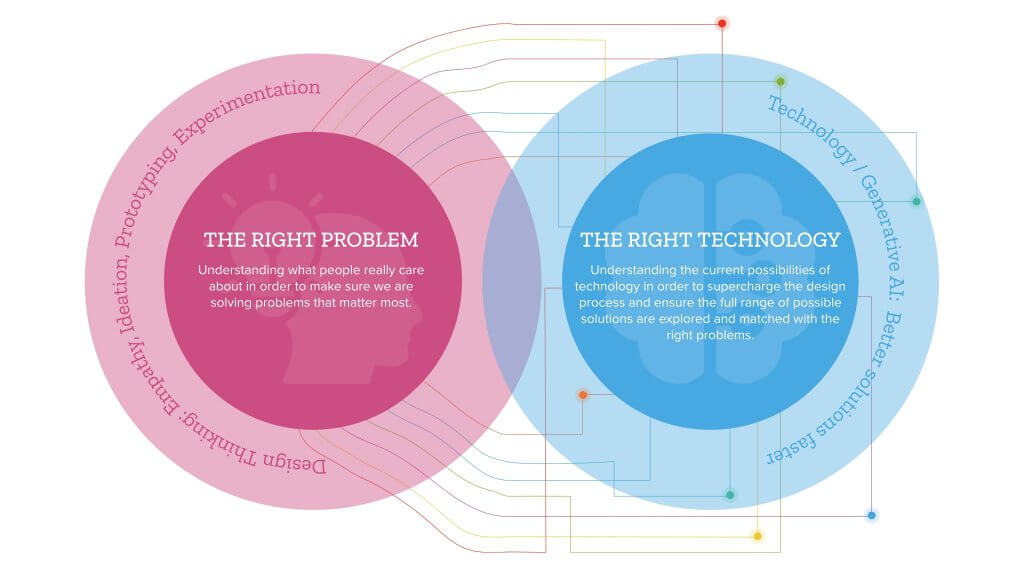AI + human-centred design: Why you need both
The extraordinary rate of technological change we are experiencing right now is being felt in virtually every sector. With around 250 new artificial intelligence (AI) applications launching every week, the challenge to ‘stay current’ is overwhelming.
What’s more, as the possibilities of technology evolve, so do the needs and expectations of customers, at equal speed.
This magnitude and pace of change will lead to disruption for many businesses. And this is especially true for industries that rely on human knowledge, creativity and human expertise to create value – think financial services, healthcare, legal and other professional services, architecture, marketing, the creative arts and many others.
Some businesses will not survive. But others will use these new technologies to catapult themselves to new levels of growth.
The most successful businesses will understand two things very well:
- 1. The needs of their customers, so that they’re sure they’re addressing the right problems, and
- 2. The possibilities of technology to ensure they match customer needs with the best possible solutions.

While this may sound like common sense, it is not always common practice.
As businesses scramble to get on the AI bandwagon, we see many of them taking a very ‘solution-led’ approach to innovation – focussed more on what can be done as opposed to what should be done. Some are investing in big AI projects that later flop. Others are hiring in teams of data scientists and architects with the brief to just build AI products, fast.
In many cases these initiatives will end as expensive failures because they started as the result of FOMO as opposed to a response to a validated customer need. The good news is that this can be avoided.
Solving the right problem
We can no longer assume that our customers will come to us to solve the same problems tomorrow as they do today. So businesses need to stay as close to customers as possible, so that when needs do change, they’re not caught off-guard.
This is where the tools of human-centred design (design thinking) can help. Practices such as deep customer listening, interviewing for empathy, and ethnographic user research enable us to understand not just what the customer ‘wants’ right now, but what their emerging future needs may be.
These methods are not new. However, in most organisations the challenge comes in knowing when and how to best deploy them, and then having the patience to refrain from jumping to solutions too soon. We see this a lot. Skipping these early ‘problem definition/need validation’ steps in the name of speed and efficiency. The result in many cases is wasted time and money on the creation of technically beautiful solutions that users don’t actually care about.
Human-centred design skills will matter more than ever
Avoiding these pitfalls and consistently solving the right problems takes more than just tools. It requires the people in your organisation to have developed an underlying set of skills and behaviours that make the detection of weak signals second nature – a natural byproduct of how work gets done everyday.
Businesses need people capable of immersing themselves fully in the user experience, spotting opportunities whilst being aware of their own biases, tolerating ambiguity and discerning the deeper meaning in stories they hear from others.
It is these ‘uniquely human’ skills that are only going to grow in importance as AI technologies become increasingly capable of performing the more transactional, technical and hard knowledge-based aspects of work.
Organisations should be developing these skills in their people with just as much urgency as they are seeking to recruit AI specialists and machine learning engineers. Those who don’t, risk losing touch with their customers, chasing the wrong problems, and finding themselves on the wrong side of disruption.
Matching user needs with the right technology
Focusing on the right problems is essential for staying relevant to your customers, but it’s not sufficient. Once a need or opportunity is identified, companies have to be able to cut through the noise of the overwhelming options, opinions and hype to match those needs with the right technological enablers and solutions.
This means staying closely tuned into developments in tech like generative AI, as well as to how such developments could help create new kinds of value and solve customer problems in new ways.
Now, this level of technical understanding exists within many organisations already – often in their technical teams. But this is no longer enough.
Today, the possibilities of AI need to be understood by anyone in the organisation who is responsible for decisions related to product or service strategy, design, development, delivery and support – especially leaders and those in charge of strategy
Despite an endless flow of AI articles and thought pieces over the last decade or more, it seems that many leaders were still caught off guard when tools like ChatGPT burst into the mainstream. AI moved suddenly from “coming soon” to “now here” – and a lot of leaders were not as ready as they thought they were.
This presents a real challenge. AI, like other new technologies that came before, has a steep learning curve, and can feel impenetrable and esoteric to the non-technical specialist. Until more people outside of the tech team become fluent in the language of AI and what it’s really capable of, there will remain a perilous disconnect that will inhibit organisations from effectively responding to new needs as they emerge.
Customer knowledge + tech expertise: Bridging the gap
Addressing this disconnect does not require everyone in an organisation to become an AI expert any more than it should mandate tech teams taking charge of org-wide strategy. Rather, what is needed now are better ways of bridging the gap between those closest to customer needs, and those closest to the technology.
As the AI boom continues to gather momentum, we foresee a growing need for novel ways to help non-technical people to engage with AI and understand what current technologies are really capable of, and just as importantly, what they’re not.
At Treehouse, we’ve partnered with a group of AI specialists – 33A – who have helpfully broken down the actual ‘functions’ or ‘jobs’ that AI can perform into a clear and intuitive taxonomy. In collaboration with business strategy experts like Dr. Judith Cardenas, this taxonomy is made accessible to business leaders using a simple, and ever-evolving, set of “AI cards” – making it easy for non-technical stakeholders to navigate the real possibilities of AI, and start to engage with it in a very tangible way. 
Once we begin speaking the language of specific functions within categories like “AI senses the environment” or “AI makes decisions and recommendations”, matching technology to user needs becomes more manageable.
As AI develops, we envision the role of “bridging mechanisms” like this growing rapidly in importance – and potentially holding the key to better collaboration and better solutions overall.
AI enhances the design process
Beyond shaping the solutions that emerge from a human-centred design process, AI is also radically enhancing and accelerating the process itself.
AI algorithms help process vast amounts of customer data, identify patterns, and extract insights that we as humans may overlook. They are also capable idea generators that boost brainstorming efforts and help with convergence.
And perhaps most notably, by leveraging AI, designers can quickly build immersive visuals, as well as working digital prototypes, in seconds. This allows for shorter iteration cycles and feedback loops, reducing time-to-market and enabling the exploration of more design alternatives.
The future’s bright
We’re just entering the early stages of a technology-driven revolution that will have profound implications for the world we live in – many of which we’re only beginning to be able to imagine.
As the capabilities of technology continue to evolve, so will the role that we as humans play in solving the next wave of challenges.
To quote one of my favourite authors, Roberto Verganti: “As creative problem solving is significantly conducted by algorithms, human design increasingly becomes an activity of sense making, i.e. to understand which problems make sense to be addressed.” 1
While this changing role of the human may conjure some feelings of fear and uncertainty for some, we are looking to the future with optimism. By leaning into the skills that make us human, and learning how to adapt those skills in the age of AI, we find ourselves better equipped than ever before to tackle the complex problems of our age.
More of our biggest problems, as businesses and society, will be matched with better solutions, faster than has ever been possible before. That’s a future we’re excited to be a part of.
Run an AI + human centred design workshop with your team today to explore opportunities to create new kinds of value for your customers and teams.
1 Roberto Verganti, Luca Vendraminelli, Marco Iansiti, Design in the Age of Artificial Intelligence, Working paper 20-091, Harvard Business School
